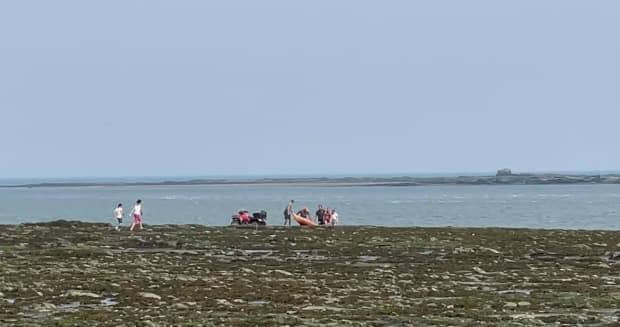Musicians rescue stranded mother and daughter, warn others of treacherous stretch of river

Hélène Lemay thought the screams were coming from a group of friends playing around near the water at first, but she soon realized what she was hearing was a desperate cry for help.
Lemay, a trombonist, saw a mother in her 40s stuck on a sandbank with her 10-year-old daughter more than a kilometre off the shores of L'Isle-aux-Coudres, in the Charlevoix region near Quebec City.
On Monday, she woke up her husband, André Moisan, and called emergency services. Moisan quickly got his kayak and paddled towards the rising tide of the St. Lawrence River.
"With the time it took [for me to get there], they already had water up to their knees because it goes so fast," said Moisan, who is a clarinet and saxophone player with the Montreal Symphony Orchestra.
"I was happy to have my kayak there...There were almost 50 people, right there on the shore [and] looking and crying, because they couldn't do anything."
Moisan was eventually able to get both the mother and daughter aboard his kayak and bring them to safety. As thankful as the mother and daughter were for his efforts, he says they couldn't really find the words.
"They were in a state of shock because they could not talk. They cried so much, they shouted so much," the musician said.
"They stayed [for] like an hour in the ambulance just to calm down and just to realize that they were okay, which is normal. I was shaking too."

'It's beautiful, but it's dangerous'
Moisan says there are signs in the area to warn people about the rising tide and urge them not to stray too far away from the shore.
Still, he says it's very common for people — especially tourists — to walk a few kilometres into the water, thinking they'll have more than enough time to notice the changing conditions and walk back to safety.
"You think the water will come right in front of you and you will see it, but the thing is they don't realize the water is coming in their back while they're walking," said Moisan.
"And then when they turn back, it's too late."
He says the area's inaccessibility to boats makes it particularly tricky, given the water level and its rocky surface.
"It's high enough water to drown, but not enough with the rocks to have a boat there," he said. "You can have over 12, 14 feet of water over your head.
Going forward, Moisan says he will have his kayak accessible near his home even if he isn't there. But if people insist on venturing out onto the water, he's pleading with them to know what levels the tide could reach beforehand and to bring safety equipment with them in case they get in trouble.
"People have to be extra, extra careful," he said. " "The St. Lawrence River, it's beautiful, but it's dangerous."

